CAMPUS

INNOVATIVE BREEDING PLACE FOR START UPS AND SCALE-UPS
EAT, WORK-OUT AND INSPIRE
TECHNOLOGICAL ECOSYSTEM
OF 300 COMPANIES AND 12.000 EMPLOYEES
25 YEARS OF HTCE



INNOVATIVE BREEDING PLACE FOR START UPS AND SCALE-UPS
EAT, WORK-OUT AND INSPIRE
TECHNOLOGICAL ECOSYSTEM
OF 300 COMPANIES AND 12.000 EMPLOYEES

The people you see here have two things in common. They were all patients at some point, and they all have a place in nature that they longed to get back to. A beautiful place on earth that brings joy to their lives. A place where they feel free.
At Philips, we’re driving sustainable healthcare. This means creating the best possible solutions to help healthcare professionals care for patients and the planet with the same attention and urgency.



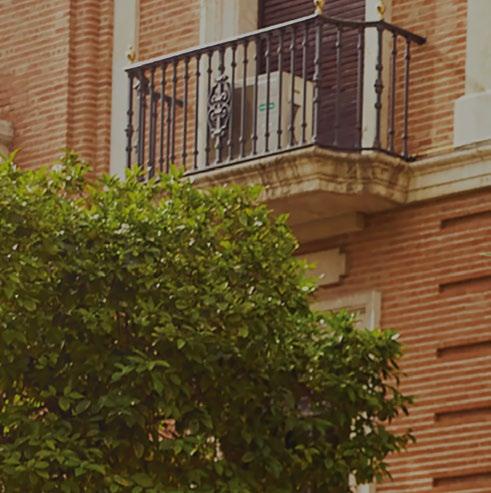

We have more than a hundred years of cycling engineering experience. That’s why our e-bike systems feel natural to ride. It’s an electric cycling experience that’s intuitive. Power assist that follows your input. A system that keeps you in control. Engineering that makes your e-bike more than the sum of its parts. Ask for Shimano E-Bike Systems at your local bike dealer.










High Tech Campus Eindhoven, also known as the smartest square kilometer in Europe, is a vibrant ecosystem home to around 300 innovative companies. Every day, more than 12,000 researchers, engineers, and visionaries work here on the technologies and businesses of the future.
Over 25 years ago, Philips took a groundbreaking step by opening the Natlab, a decision that highlighted the power of collaboration. We celebrate this special milestone under the theme ‘Rewind & Fast Forward.’ We look back at past successes to draw inspiration for a future full of new opportunities. Collaboration remains the driving force behind the Campus, where groundbreaking innovations with global impact are born.
High Tech Campus Eindhoven is an international meeting place with over 100 nationalities spread across 280,000 square meters of offices and high-tech facilities. Thanks to its strategic location, close to major highways and international airports, the Campus is an attractive destination with both local and global appeal. With extensive amenities in The Strip, such as restaurants, shops, sports facilities, childcare, and a conference
center hosting over 300 events annually, the Campus provides everything an innovative community needs.
For both startups and established companies, the Campus serves as an inspiring breeding ground. They benefit from access to venture-building programs, investors, and advanced R&D labs designed for pilots and small-scale production. Sustainability is a core value, with green energy solutions and innovative initiatives contributing to a healthy and inspiring working environment.
The focus remains firmly on the future. High Tech Campus Eindhoven continues to grow as the place where innovation, collaboration, and a touch of Brabant hospitality come together. We invite you to become part of this unique ecosystem and to work with us to shape the world of tomorrow.
Enjoy reading!
Otto van den Boogaard CEO High Tech Campus Eindhoven



CAMPUS
EDITOR-IN-CHIEF
Hilde de Vocht
PRODUCTION &
Eva Wellens
CONTRIBUTORS TO THIS EDITION
Cheryl Boyd, Terry Boyd, Koen Chatrou, Bregje van Dommelen, Djaydee Kraus, Eveline Lamers and Arnold Otten
PHOTOGRAPHY
Charlotte Verhagen/DCI Media, High Tech Campus Eindhoven

GRAPHIC DESIGN
Leon Torremans PRINTING PreVision
COPYRIGHT
Reproduction of articles as defined in Article 15 of the Copyright Act is not permitted.
HTCE SITE MANAGEMENT
High Tech Campus 1(e) 5656 AE Eindhoven +31 (0)40 – 230 55 00 www.hightechcampus.com info@hightechcampus.com

Philips presents an ambitious plan to establish a central R&D center in Eindhoven. This initiative forms the foundation of what will later become the High Tech Campus, aimed at fostering technology development and collaboration between companies and knowledge institutions.
The construction of the first facilities kicks off. Philips initiates the development of the Campus to consolidate research and innovation in a single location, featuring high-quality laboratories and shared workspaces.


HTC 31 is completed, providing space for the first research departments. This building plays a key role and later houses the Holst Centre, a renowned research institute for sensor technology and flexible electronics.
Philips decides to open the Campus to other companies and knowledge institutions. This strategic choice marks the beginning of an open innovation ecosystem where diverse organizations collaborate.


Construction of The Strip starts. This will become the social and logistical heart of the Campus, with facilities like restaurants, cafés, and conference rooms. The Strip fosters interaction and collaboration among employees from various companies.

Philips officially renames the Campus High Tech Campus Eindhoven. This name change strengthens the Campus’s position as an international hub, open to various companies and institutions beyond Philips.
The Sports Forest, named after Frits Philips, opens, offering employees a place to relax and exercise. This green area plays a significant role in promoting well-being on the Campus.
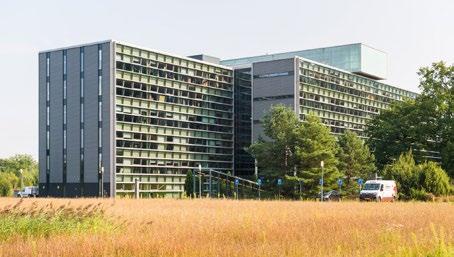

NXP sets up its research facilities on the Campus, reinforcing its focus on semiconductors and contributing to the Campus’s technological community.
The Campus gains its own exit on the A2 highway, improving accessibility and making the Campus more attractive to international visitors. This enhancement underscores the strategic location of HTCE in the region.

Over 100 companies are established on the Campus, highlighting the success of the open innovation vision. This diversity creates a unique environment for collaboration and cross-pollination across different sectors.

The Ministry of Economic Affairs recognizes the Campus as a “nationally significant campus” due to its crucial role in the technological development of the Netherlands. This status strengthens HTCE’s strategic value as an innovation center.

Philips sells the Campus to a consortium led by Dutch investor Marcel Boekhoorn, while Philips remains a tenant. This acquisition marks a new era of independence and growth.


The HighTechXL accelerator is launched to support startups in the high-tech sector. The program provides young companies with access to capital, mentoring, and networks, helping them grow and innovate quickly. HighTechXL eventually starts building its own startups.
In June 2014, Solliance officially opens its new building on the High Tech Campus Eindhoven. Approximately 250 guests attend the event, unveiling facilities equipped with advanced manufacturing equipment for thin-film solar cell research.
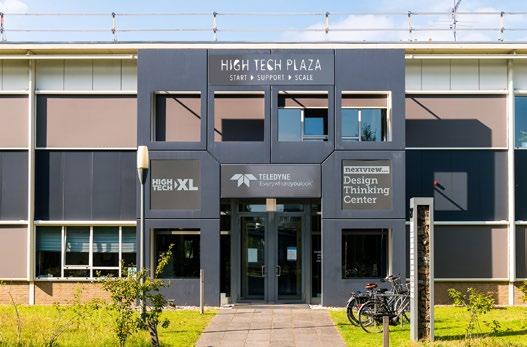

High Tech Plaza opens as a dedicated hub for startups and scale-ups, featuring flexible workspaces and shared facilities. This new space strengthens the Campus’s role as a breeding ground for young tech companies and entrepreneurs.
The Fe+male Tech Heroes network is founded to promote gender equality and diversity in the tech industry. This initiative provides a platform for women to network, develop, and pursue leadership roles in technology.
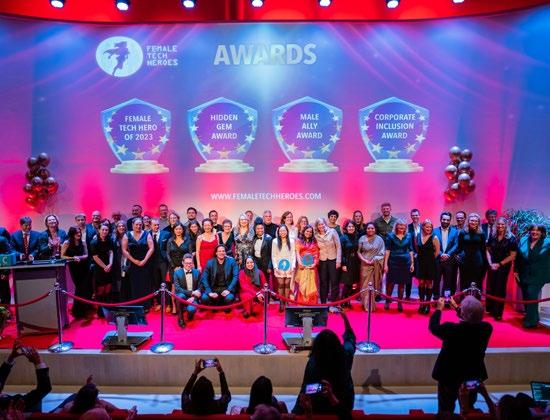

The AI Innovation Center opens as the first innovation hub on the Campus focused on artificial intelligence and data technology. This center provides a platform for AI experimentation and collaboration within the Campus ecosystem, part of the Campus2030 strategy.
Signify Benelux moves to the Campus and opens a large research center focused on smart lighting solutions and sustainability.


The Royal Family celebrates King’s Day on the Campus. From a high-tech studio, they follow an interactive program, learning about innovative projects and ventures from the Brainport region.
American investment firm Oaktree Capital, in collaboration with GIC, acquires the High Tech Campus. This acquisition enables new investments and provides the Campus with additional capital for future growth and internationalization.


HTCE celebrates its 25th anniversary with various events highlighting the Campus’s history, achievements, and future vision. This anniversary marks a quarter century of collaboration, innovation, and growth as a European technology center.

TEXT: KOEN CHATROU PHOTOGRAPHY:
CHARLOTTE VERHAGEN - DCI MEDIA / HTCE
If you think High Tech Campus Eindhoven (HTCE) is just a collection of buildings, you need to see it for yourself. Or have a conversation with Elsbeth Smit and Jeroen Triepels. They are part of HTCE Site Management and are eager to share how, on the edge of the Genneper Parks, an ecosystem has emerged that forms a key foundation for the innovative developments in the Brainport region.
Elsbeth Smit, Director of Business Development, and Jeroen Triepels, Director of Operations at HTCE Site Management, are part of the team driving the Campus’ development and growth. Today, HTCE is home to around 300 companies with approximately 12,000 employees, but it’s ready for the next phase: expanding to about 20,000 employees by 2030.
At its core, the Campus provides housing for companies of all sizes, from solo entrepreneurs and tech startups to scale-ups, SMEs, institutes, and large multinationals—all with a link to technology. So, what makes HTCE so unique? Jeroen explains: “We provide tailored facilities for tech-oriented companies, understanding that businesses, especially those in growth phases, require specific types of space. Whether it’s offices, labs, cleanrooms, or workshops, we can accommodate it all.”
He adds that companies’ needs often change quickly as they develop rapidly. “We adapt to these changes. We’re flexible and align ourselves with the needs of our residents.” How does Site Management know what companies need? “We keep in constant dialogue with the companies here. We follow their journey and quickly respond to their evolving demands. While surprises from global companies do happen, we usually see the trends coming.”
In addition to providing space, Site Management offers a range of other services. “We take care of everything,” Elsbeth says. “From technical maintenance to secure internet, coffee and tea, parking, public transport options, a variety of restaurants, safe waste disposal—including chemical waste—and a green, inspiring work environment. We call it a full-service package.”
They also hold an overarching environmental permit, given the chemical materials used by many companies on-site. “We have a facility that stores
about 8,000 different chemicals in various quantities. Whatever our residents need—emergency power, compressed air, oxygen—you name it, we’ve got it.”
As HTCE has grown, so has the need for supporting businesses. Jeroen notes: “That supporting layer is here, too, allowing companies to connect quickly. What kinds of businesses? Better to ask, which aren’t here? Car rentals, HR services, expat services, grant consultants, advisory services, a bank, and even a patent office.” A patent office? “Yes, and it makes sense. Nearly half of all patents granted in the Netherlands come from this one square kilometer.”
Walking along The Strip, the Campus’ central meeting hub, it’s clear that this is unlike any typical business park. There are restaurants with diverse cuisines, cafes, shops, a conference center, childcare facilities, a farm, sports facilities including a padel court and sports forest, a wellness center, and even a bike repair shop.
“Companies don’t come here just for office space,” Jeroen explains. “They want to be part of an ecosystem—a system that fosters connections, knowledge-sharing, and innovation. Over 100 nationalities work here, leveraging innovation hubs and each other’s expertise.”




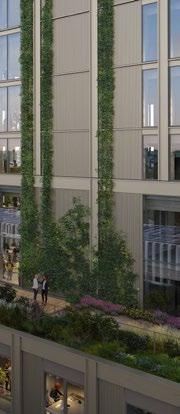


Sharing knowledge, also known as Open Innovation, is a cornerstone of the Brainport region and the Campus. “Our mission is to bring like-minded people together,” Elsbeth says. “Companies want to grow, and we help facilitate that growth. Here, people share a passion for improving the world through technological solutions. It’s our job to help them connect, whether through targeted matchmaking between companies, frequent conversations with entrepreneurs, or organizing events—be it sports activities, networking gatherings, or knowledge-sharing sessions. We have a fantastic ecosystem, but it requires constant maintenance.”
‘Companies don’t come here just for office space, they want to be part of an ecosystem’
Does Open Innovation mean companies are willing to share knowledge, even with competitors? Jeroen says, “Absolutely. Knowledge sharing is in the DNA of modern businesses. Everyone knows the limits of what can and cannot be shared. It works well. Innovators understand that collaboration is essential to progress—you can’t innovate in isolation.” Elsbeth adds, “The world outside your company is much larger than what’s inside. Other companies are discovering and creating things
you can use, so why reinvent the wheel?
At the same time, others benefit from your knowledge. That’s how we advance together. I think it’s also part of the Brabant culture—a willingness to help and collaborate wherever possible.”
The coming years will focus on scaling up. The Brainport region expects to add around 50,000 jobs by 2032. Elsbeth explains, “Approximately 6,000 of those jobs will be on HTCE, focusing on innovation, research, and development. Our job is to facilitate that growth.”
“No problem,” Jeroen says confidently.
“We’re already preparing for it. We anticipate needing an additional 150,000 square meters of facilities. This will make the Campus even more innovative and international. Of course, we recognize challenges, such as housing. Temporary housing on the Campus? Why not? As long as we preserve the area’s green character. Challenges are inevitable, but the willingness to strengthen this region together is evident. Within this remarkable ecosystem, we’ll continue to do our part.”
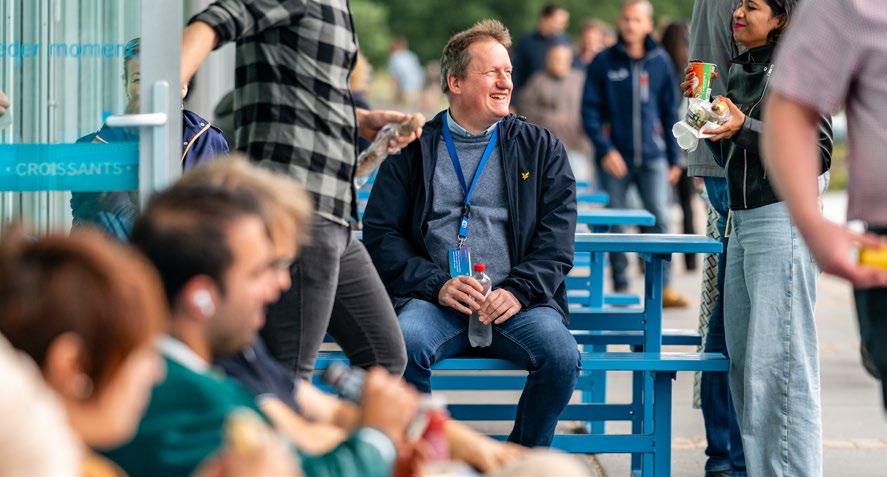


Working on the future requires fuel for both body and mind. At High Tech Campus Eindhoven, you’ll find not only cutting-edge technology but also a culinary selection that adds a delicious boost to every workday. Whether it’s brainstorming over a light lunch, savoring an exotic curry, indulging in a luxurious coffee break, or wrapping up the workday with drinks, the restaurants and cafés on the Campus are the perfect places to connect, recharge, and stay inspired.
The best part? These facilities aren’t just for the Campus community—they’re open to everyone in the Brainport region. Whether you work nearby, are visiting, or simply want to enjoy a delightful meal in an inspiring setting, the Campus welcomes you with open arms. Sharing a meal here always leaves you wanting more!
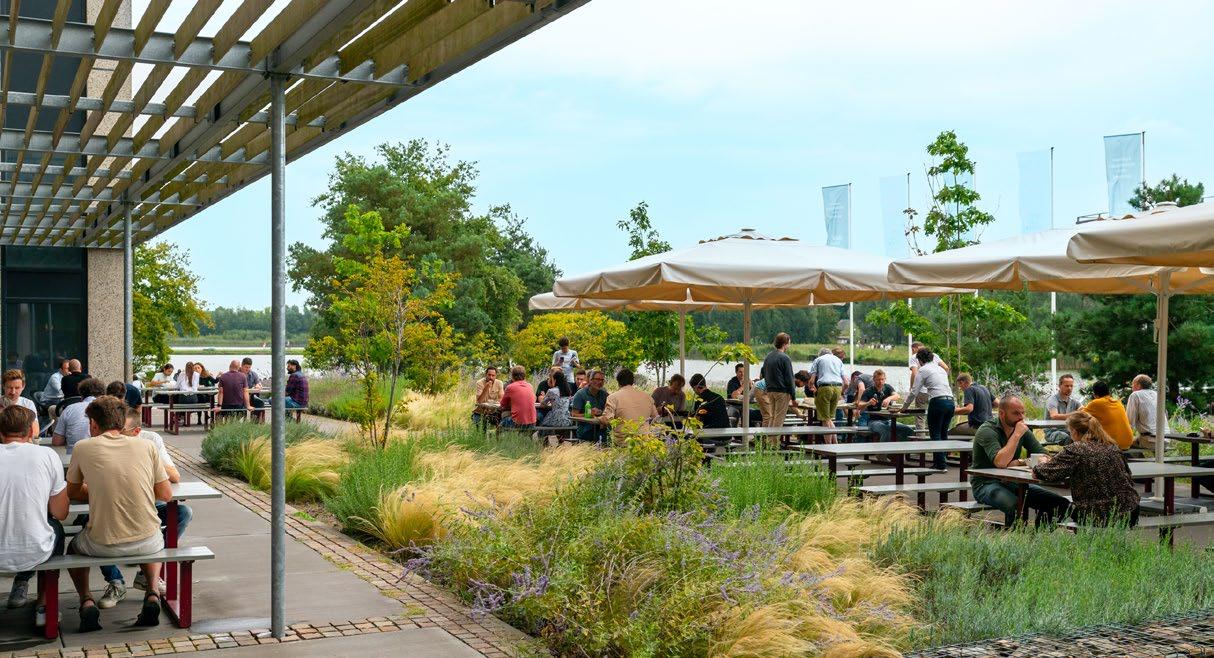

1. TLab (HTC 5)
A cozy coffee and tea bar offering a variety of coffee specialties, unique tea blends, and sweet treats.
2. LOKL (The Strip)
A premium coffee spot serving Starbucks specialties, perfect for a quick break or a meeting with colleagues.
3. Brave New World (HTC 5)
Enjoy a healthy and varied lunch with a rotating menu of fresh salads, warm meals, and light snacks.
4. Okinawa (HTC 5)
Light, digestible dishes inspired by Japanese cuisine, including sushi, ramen, and other Eastern delicacies.
5. Subway (The Strip)
A quick and fresh sandwich option with a wide range of customizable choices.
6. The Mart (The Strip)
A self-service restaurant offering fresh, organic dishes, including warm meals, salads, and soups.
7. Love My Curry (The Strip)
Authentic Indian curries, tikkas, and koftas prepared with fresh herbs and spices, perfect for fans of bold flavors.
8. Daely (The Strip)
A sustainable choice featuring a daily changing menu of soups, sandwiches, and snacks for a nutritious lunch.
9. FoodLab (The Strip)
A vibrant square with diverse food trucks offering a range of street food, from pizza to barbecue dishes, in an informal and cozy setting.
10. Grand Café The Lucky Swan (The Strip)
Perfect for lunch, dinner, or drinks, with an extensive menu and a relaxed atmosphere for both business and casual meetings.
11. The Lounge (The Strip)
Luxury business dinners, drinks, and cocktail parties in a stylish setting with refined menu options.




TEXT: ARNOLD OTTEN PHOTOGRAPHY: HTCE
Between meetings, Philipp has a moment to chat. Originally from Germany, he prefers speaking English but is steadily improving his Dutch. “My colleagues are a big help,” he laughs. Philipp studied Business Administration and Economics, worked as a Business Developer, and was searching for a role that centered on innovation and innovative processes. That role took him across the border to Eindhoven. “It took some adjustment,” he admits. “I previously lived in cities like Berlin and Munich, and Eindhoven is much smaller. But I quickly discovered that the Dutch are far ahead in automation and digitization. Now I’m convinced Eindhoven is a rising star. My friends don’t know the city yet, but in ten years, they’ll all want to come here—I’m sure of it.”
At High Tech Campus Eindhoven, innovation hubs are where new ideas take shape. These hubs host both major Brainport region companies like ASML and Philips and smaller scale-ups and startups. “Open innovation is the key term here,” Philipp explains. “This ecosystem fosters the sharing of knowledge about emerging technologies. For instance, where we are now—the AI Innovation Center—is one such hub, a meeting place where new ventures are born and early-stage developments are nurtured with fresh energy. Call it a breeding ground, an ecosystem, or whatever you like—this is where innovation begins. It’s where companies, educational institutions, and research organizations come together to think about the future and the opportunities technology provides.”
The smartest square kilometer in Europe—imagine working there. For Philipp Werle, it’s a reality. In 2022, he moved from Cologne to Eindhoven, where his business card now reads “Innovation Manager Emerging Tech.” However, Philipp isn’t a fan of the phrase “smartest kilometer.” “It sounds a bit arrogant,” he says. “It doesn’t match the openness and open innovation we strive for.”
To bring companies together and showcase what’s happening on the Campus, regular events are organized. Companies give presentations about their projects, which Philipp considers a great initiative. He also believes the Campus could adopt a more open and approachable image. “What many people don’t realize is that a lot of work here focuses on social innovation,” he explains. “For example, there are virtual reality programs being developed to help visually impaired individuals navigate their surroundings. There’s also research into workplace bullying and how to address it.”
Another little-known fact is the growing collaboration with the Design Academy Eindhoven. “Eindhoven is a city of technology, but it’s also a city of design,” Philipp notes. “I believe we can bridge the gap between technology and creativity here. Maybe we dress differently or have a different mindset, but I think we complement and strengthen each other enormously.”
Philipp is optimistic about the future of High Tech Campus Eindhoven. “The strength of this Campus lies in its diversity. There are global giants here, but also smaller companies. It’s incredibly rewarding to watch these smaller companies grow through the stages of entrepreneurship. With this unique mix and the proximity of specialized knowledge, we might just see the next Philips or NXP emerge here. Who knows?”
Companies at High Tech Campus Eindhoven develop new technologies and applications that address societal challenges and successfully introduce them to the market. This combination of technology and business is central to the many collaborations on the Campus. Multinationals like Philips, NXP, and Signify, high-tech SMEs, research institutes, service companies, scale-ups, and startups work together here on the technologies and products of tomorrow. With over 12,500 international researchers, developers, and entrepreneurs, the Campus is a hub of knowledge and dynamism. High Tech Campus Eindhoven is one of the world’s leading hotspots in Health & Vitality, Sustainability, Applied Intelligence, Smart Environments & Connectivity, and Software & Platforms. www.aiinnovationcenter.nl www.in3eality.com





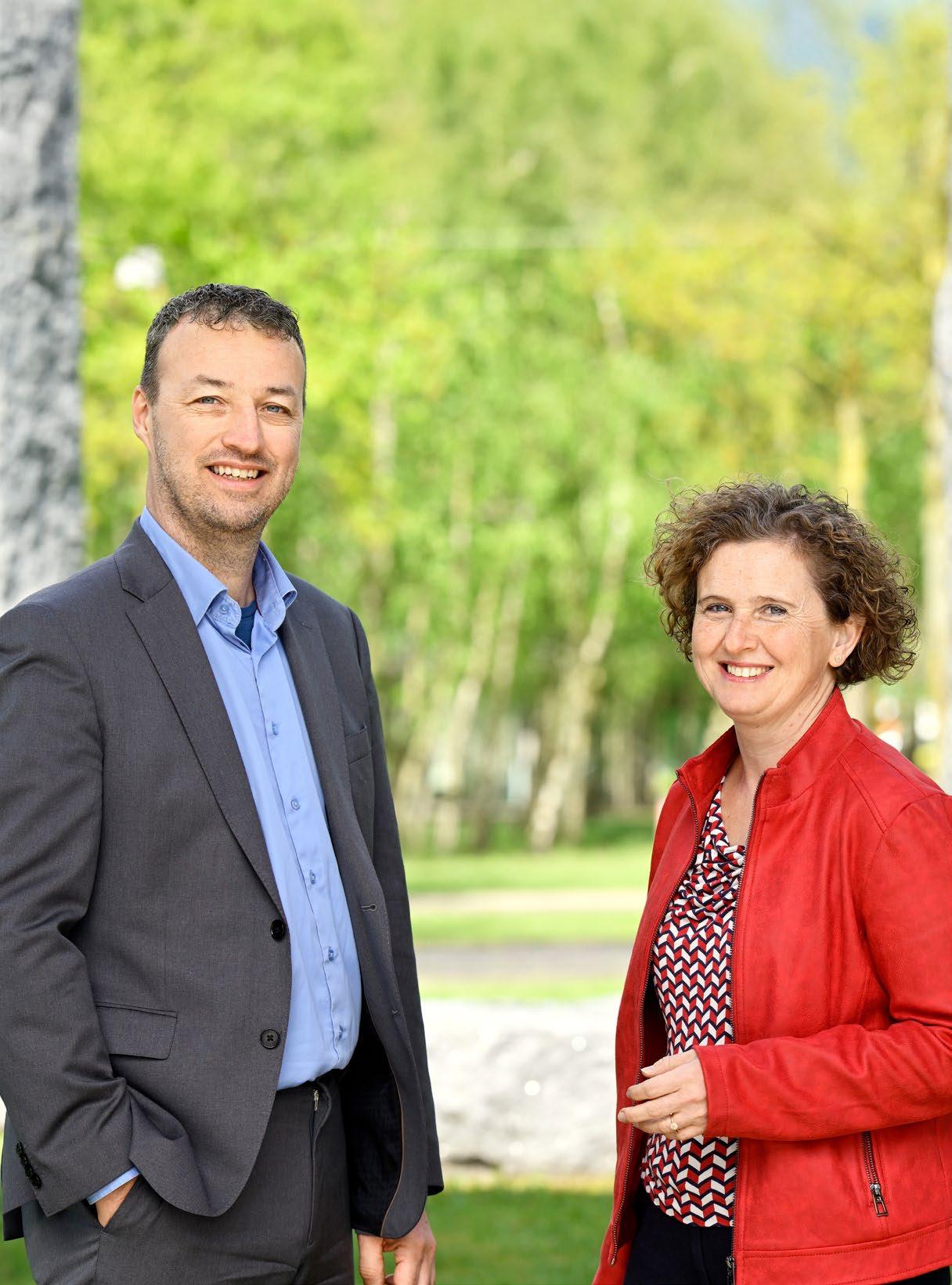
TEXT: DJAYDEE KRAUS
PHOTOGRAPHY: BART VAN OVERBEEKE / VERSE BEELDWAREN
Let’s rewind to the early years of High Tech Campus Eindhoven. Companies on the Campus soon realized the need for an organization that could help them accelerate innovations to market. Philips approached TNO and imec. “There was already significant overlap between our organizations,” Philips explains. “By joining forces, we became stronger.” What began with a small team of 15 enthusiasts has grown into an institute with over 250 engineers and researchers. Van Mol adds: “What we’re doing here is truly unique—two research institutes from different countries working together under one roof. You won’t find that anywhere else.”
What sets Holst Centre apart from a university? “At Holst Centre, applied research is the focus,” explains Philips. “This differentiates us from universities, which often concentrate on fundamental research. Universities aim to uncover scientific discoveries and understand the principles behind technologies. While that research is valuable, it often takes a long time to lead to concrete applications. At Holst Centre, we focus on bridging that gap:
High Tech Campus Eindhoven and Holst Centre have been interconnected since the beginning. Not long after the Campus opened its doors, Holst Centre was established as a collaboration between the Flemish research institute imec and the Dutch knowledge organization TNO. This shared starting point has not only led to groundbreaking research but also to new business ventures. “The Campus was born from the idea of open innovation, which is precisely the essence of Holst Centre,” say Kathleen Philips and Ton van Mol of Holst Centre.
developing technologies that can immediately benefit companies.”
Van Mol adds: “We work closely with industrial partners and tailor our projects to their specific needs. This makes our work not only practical but also faster to implement. While universities explore what’s possible, we focus on what’s needed.”
One example of such an application is the smart patch. “The pressure on healthcare is a major challenge today,” Van Mol explains. “How can we continue to provide care with fewer staff and an aging population?” Holst Centre offers solutions by automating diagnostics.
“In hospitals, vital signs are still largely measured manually, which requires time and personnel. We’re developing patches that automatically measure functions like heart rate and blood pressure and wirelessly send the data to patient records. This makes healthcare more efficient and gives patients greater freedom.”
The technology, developed in collaboration with industrial partners, isn’t just about efficiency. “We want people to go home sooner and feel more like themselves instead of patients. An additional benefit of this technology is that it reduces the workload for healthcare staff.”
Another technology being developed at Holst Centre is organ-on-a-chip. “This technology allows for faster and animal-friendly drug development,” Philips explains. “It also paves the way for personalized medicine.”
Van Mol adds: “In the future, we’ll be able to incorporate patient tissue
‘With photonic chips, we can develop faster, more accurate sensor technologies’
onto the chip to test which drugs are most effective. This will make treatments more precise and tailored to the individual.”
While the technology is still under development, Holst Centre expects the first applications to reach the market within five years. “This will truly revolutionize healthcare.”
Holst Centre is also focusing on photonics. “Chips that use light instead of electricity are not only more energy-efficient but also faster at processing information in certain applications,” says Philips.
One example is a photonics-based oxygen meter that measures blood oxygen levels independently of skin color. “Current devices using LED light gave inaccurate readings for people with darker skin during COVID,” Van Mol explains. “This technology eliminates that problem.”
Photonics also has potential in sectors like automotive and healthcare.
“With photonic chips, we can develop faster, more accurate sensor technologies,” Van Mol says. Thanks to European investments and the presence of innovative startups and scale-ups in Brainport Eindhoven, the region is a leader in photonics. “It strengthens our innovation
capabilities and our international position,” Philips adds.
Innovations like smart patches, organ-on-achip, and photonics are just the beginning. “The pace of technological development is accelerating, especially with the use of AI,” Van Mol explains. “AI allows us to analyze data faster and recognize patterns that would otherwise go unnoticed. This speeds up innovation and makes applications like personalized care increasingly possible.”
Philips emphasizes: “The challenges in this field are immense. In the U.S. and China, billions are invested in innovation. To compete, we must collaborate. Fortunately, that awareness is strong here in the Brainport region.”
Since Holst Centre was founded in 2006, the geopolitical landscape has shifted. While international collaboration was the norm


then, the world is now divided into blocs. “Today, we primarily work with partners in Europe and other Western countries like the USA and Japan,” Van Mol says. “This makes the collaboration between imec, TNO, and other European entities even more critical.” Philips adds: “Innovation isn’t possible without collaboration. Whether it’s photonics or organ-on-a-chip, the challenges are too great to tackle alone. Here in Brainport, we understand that better than anywhere else.”
Holst Centre has spawned over 12 startups, its “offspring.” A notable example is Onera, a spin-off (now a scale-up) that developed wearable sleep monitoring technology. “The company helps people with sleep problems without the discomfort of traditional equipment,” Van Mol says.
‘To compete, we must collaborate. Fortunately, that awareness is strong here in the Brainport region.’
Another example is Lionvolt, focused on battery technology. These spin-offs benefit from Brainport Eindhoven’s ecosystem, where companies, knowledge institutes, and governments collaborate intensively. “The presence of major players like ASML and Philips makes it easier for startups to find partners and grow,” Van Mol notes.
The ecosystem also attracts international talent. “Young researchers from all over the world come to our region,” Philips says. “Many of them stay, build lives here, and transition into the industry. This strengthens our region economically. But our impact isn’t just economic—we also have a societal impact through the applications we’ve mentioned. And that’s something to be very proud of.”

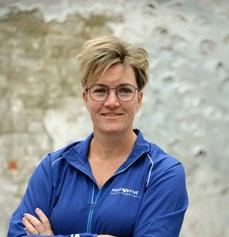
At High Tech Campus Eindhoven, there are numerous opportunities to stay active during the workday. The Campus Wellness Center offers a variety of facilities, including fitness programs, personal training, and group classes tailored to every fitness level. For outdoor enthusiasts, there’s the Sports Forest, where you can play basketball, volleyball, tennis, cricket, padel, and soccer. Additionally, there are four designated WorkWalk routes across the Campus, ideal for walking meetings with colleagues while enjoying the green surroundings. Whether you prefer an intensive workout or a relaxing stroll, the Campus has something for everyone to keep both body and mind in balance.
“Sports bring people together and inspire, and we see this reflected in every event on the Campus. Whether it’s the team spirit at the 5x5 soccer tournament, the challenge of the mountain bike race, the speed of the Campus run, or the resilience shown during the triathlon – there’s a sporting adventure for everyone. Together, we’re building a healthy and vibrant community!”
Bjorn van den Langenberg, Event Manager Sport, High Tech Campus Eindhoven
“The Campus Wellness Center offers more than just a place to work out. We create a space where you can recharge, challenge yourself, and step away from the bustle of the day. Everyone deserves the chance to stay at their physical and mental best.”
Hedske Bardie, Manager Campus Wellness Center



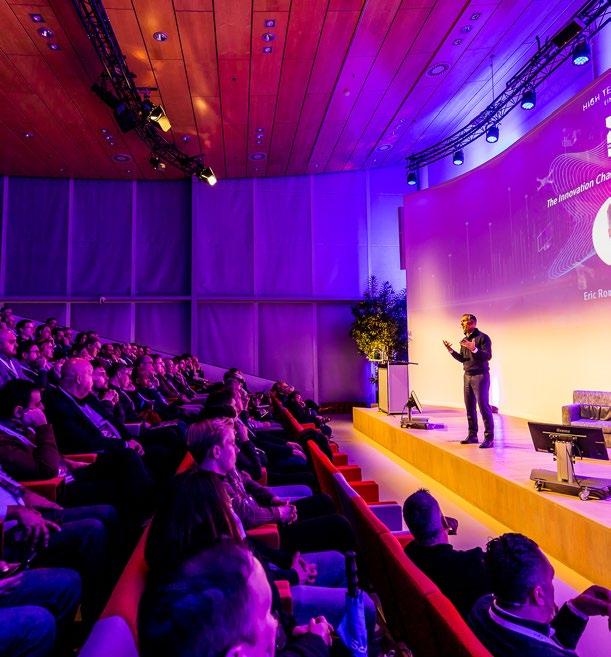








Get inspired and host your meeting or event on the smartest square kilometer in Europe!
Choose an inspiring location for your kick-off, brainstorming session, or product launch at the Conference Center on High Tech Campus Eindhoven. Situated in the heart of Brainport Eindhoven, this vibrant hotspot for innovation and technology offers the perfect setting for your event.
Featuring a state-of-the-art auditorium and nine multifunctional meeting rooms, the Conference Center is ideal for conferences, seminars, business
Interested? Get in touch and explore the possibilities! High


meetings, and networking events. Immerse yourself in the creativity and cutting-edge thinking of 300 companies and over 12,000 researchers who work here daily on the technologies of tomorrow.
Plan your event now and set the tone for a successful 2025! With over 500 events hosted annually, we know the recipe for success and are ready to help make your event unforgettable.
conferencecenter@hightechcampus.com www.hightechcampus.nl/conference-center


As venture builders, HighTechXL and LUMO Labs foster the development, launch, and growth of innovative tech startups aiming to tackle societal challenges using cutting-edge technologies. John Bell, CEO of HighTechXL, and Andy Lürling, founding partner of LUMO Labs, discuss their shared mission, the challenges they face, and the unique ecosystem of this region. “We often look up to Silicon Valley, but we should take greater pride in Brainport.”
TEXT: EVELINE LAMERS / PHOTOGRAPHY: CHARLOTTE VERHAGEN - DCI MEDIA / HTCE
After witnessing the inner workings of various companies, including startups and scale-ups, during his time as a tech consultant, Andy recognized where real change could be made. Coupled with his experiences as a father and entrepreneur, he laid the foundation for LUMO Labs. “I discovered my passion for creating something from nothing,” he says. “But I want to do so in sectors where I can make the most societal impact. Becoming a father gave me a new perspective on life.” The startups supported by LUMO Labs must contribute to the United Nations’ Sustainable Development Goals (SDGs), focusing on areas such as health and well-being, climate change, or sustainable cities.
HighTechXL shares a similar mission: supporting startups that use deep tech to create a positive societal impact. However, there are distinct differences between the two venture builders. “We focus on hardware, whereas LUMO Labs concentrates on software,” explains John. “Additionally, we enter the process very early. We bring together innovative technolo-
gies and individuals with technical or business backgrounds to form teams. These teams follow a 12-month intensive program to bring their innovative technology to market. This can lead to the birth of a startup.”
‘We don’t just know the processes involved in starting and scaling a company; we also understand the emotions.’
While LUMO Labs also enters early, their focus begins later than HighTechXL’s. Andy explains, “We invest in seed and pre-seed stages, meaning there’s already a technology and a team. Seed-stage startups often have one or more pilot customers. We coach them in areas like leadership, marketing, storytelling, and finding
the right product-market fit, helping them evolve into scale-ups.” Andy’s experience as a former tech entrepreneur helps him in this role. “We don’t just know the processes involved in starting and scaling a company; we also understand the emotions. I’ve been on the brink of bankruptcy twice, so I know the uncertainty founders face and how crucial resilience is.”
John also draws from his previous work experience. “At large companies like Philips, I worked on innovation, which was fantastic. But when a company’s strategy shifts, you have to adapt. I wondered how I could create even greater impact. Now, I help startups steer in the right direction using my knowledge and experience. It’s rewarding not only to create impact but also to help people thrive and grow.”
However, John stresses that success doesn’t come easy. “Every startup faces challenges. Team members may develop differing visions, or one might want to move faster than the others. Securing funding can also be a struggle. Fortunately, the network and ecosystem we’ve built on the High Tech Campus play a significant role in overcoming these hurdles.”
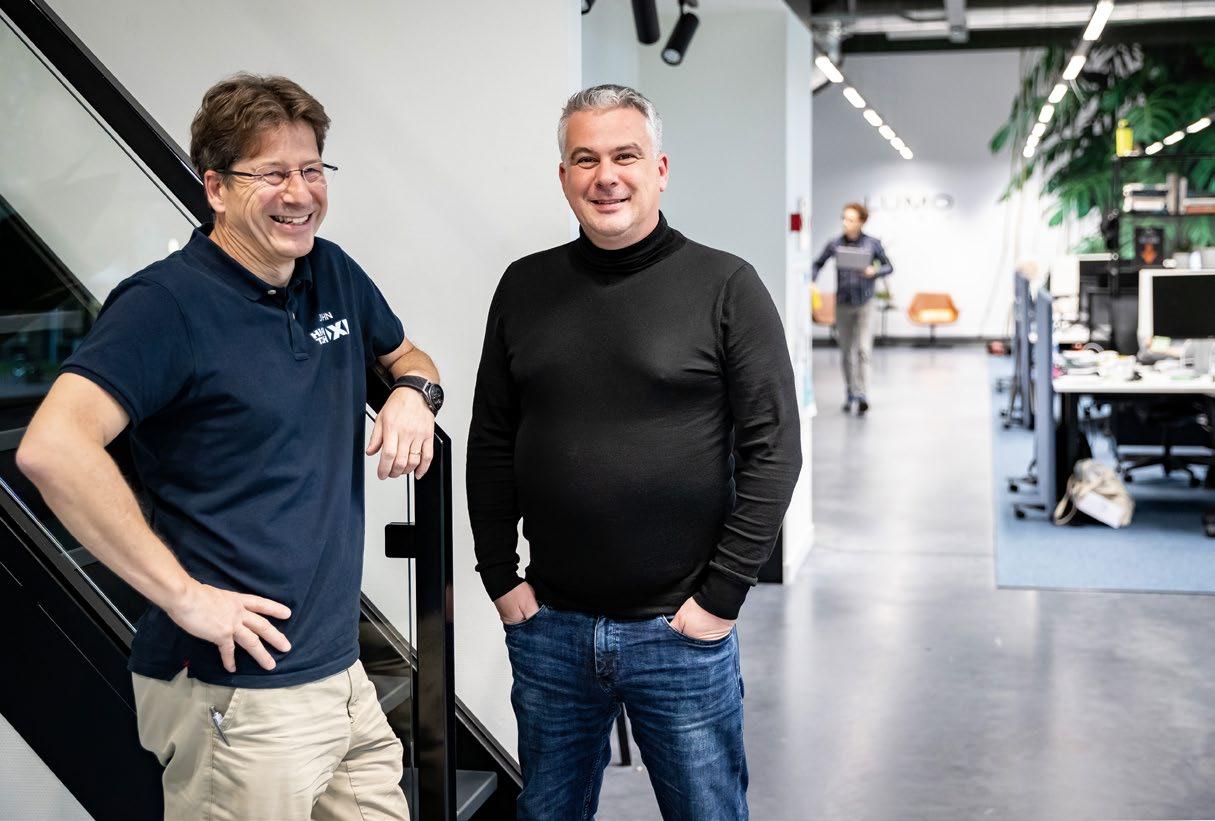
LUMO Labs invests in emerging disruptive technologies, focusing primarily on software. These are innovative, impactful technologies with the potential to completely transform existing markets or industries—think of advancements in AI.
This company develops AI-powered speech support technology for individuals with voice disorders. Whispp was named Invention of the Year 2024 by Time Magazine.
Healthplus.ai uses artificial intelligence to predict, almost immediately after a procedure, the risk of postoperative infections for patients. Their goal is to prevent chronic conditions and long-term complications.


The ecosystem, with its wealth of startups, proves to be fertile ground for success. John remarks, “Startups can connect here. The network, knowledge, and willingness of people to help one another make the High Tech Campus unique. More broadly, it makes the Brainport region unique, and we should take more pride in it.” Andy agrees: “American visitors often say this region is more beautiful and impressive than the Google or Meta campuses. While we look to Silicon Valley with awe, we have something special here.”
Still, Andy believes Europe can learn from the U.S. “In the U.S., there’s large-scale collaboration. European tech hubs often operate independently, but by learning from one another, we could achieve greater efficiency.” Both Andy and John are committed to connecting ecosystems and strengthening the position of startups and scale-ups in Europe. “We network, lobby, and foster collaboration to achieve this.”
Rather than viewing each other as competitors, Andy and John frequently collaborate. “Sometimes, I reach out just to share what’s on my mind,” Andy admits. “Not many people do this work. Right now, LUMO Labs is investing in 23 companies, which is intense. Plus, we’re both involved at the riskiest early stages. Sometimes, you just need to vent.”
‘American visitors often say this region is more beautiful and impressive than the Google or Meta campuses’
The early phase can also be the most financially rewarding. “But if you’re doing it for that reason, you’ll burn out,” Andy warns. “It takes years before a startup becomes profitable. You need to do this work because you genuinely want to help others and address societal challenges.”
The two also collaborate by co-investing in startups, lobbying governments, or organizing tech challenges like the Extreme Tech Challenge and the Draper Pitch Event. Winners receive guidance, training, or workshops to progress further. Andy and John are equally committed to diversity and inclusion. “During a visit from the Dutch State Secretary, we highlighted several female founders from our network,” John shares. “They engaged in discussions about why women are underrepresented in startups and how we can support them. It’s crucial to continue promoting inclusivity and harnessing the strength of women in our sector.”


HighTechXL invests in deep tech, with a focus on hardware. These are technological innovations with the potential for significant societal impact. Think of advancements in photonics, robotics, or complex machines that, for instance, extract CO2 from the air or improve efficiency and quality in the semiconductor industry.
AlphaBeats focuses on enhancing the mental performance of athletes, top executives, and eventually everyone. They achieve this by stimulating brainwaves to reach the optimal “state of mind.”
Senergetics uses photonics (light) to detect rust or leaks in pipes used for transporting products like milk or gas during production processes. Currently, companies handle this in a time-consuming and expensive way, but Senergetics offers a more efficient alternative.

Axelera AI develops advanced hardware and software solutions for artificial intelligence (AI), with a focus on edge computing.
Its flagship product, the Metis™ AI Platform, delivers powerful, energy-efficient AI processing for applications such as computer vision and generative AI.
In June 2024, Axelera AI raised $68 million in a Series B funding round, bringing its total funding
SCIL Nanoimprint Solutions is a leading company that develops innovative nanoimprint lithography equipment based on Philips technology. This technology enables cost-efficient large-scale production of advanced devices, such as AR smart glasses. SCIL’s approach offers an affordable alternative to expensive DUV and EUV tools.
The company was founded in 2015 when Philips Research and Philips IP&S decided to build a business case around the SCIL technology. The initial step was the development of a fully automated machine capable of imprinting nanopatterns onto substrates. In 2017, SCIL delivered its first devices, with production handled by VDL.
Following a successful investment round in 2023, SCIL separated from Philips and transitioned into an independent startup, nearly a decade after its inception.
SCIL combines Philips’ rich history with close collaboration with VDL and a promising technological solution. This combination makes SCIL a formidable player in the lithography sector, based in one of the most innovative technology hubs in the Netherlands.
to $120 million. This enables the company to continue its mission of making AI applications more accessible and cost-efficient. The company has over 180 employees, including more than 55 PhDs, spread across offices in the Netherlands, Belgium, Switzerland, Italy, and the United Kingdom. The team combines extensive expertise in AI software and hardware, gained at leading AI companies and Fortune 500 organizations.

Sandgrain focuses on enhancing security within the increasingly interconnected digital world. The company addresses critical vulnerabilities in identity verification within the rapidly growing Internet of Things (IoT) ecosystem. Sandgrain envisions a world where data is secure, networks are reliable, and sovereignty is safeguarded.
Using an innovative electronic trust anchor that acts as a robust “barcode” for security, Sandgrain takes cybersecurity to the next level. Their univer-
sal authentication platform is designed to work with any IoT device. It combines a secure cloud platform with a physical token attached to the device, offering a powerful and versatile solution to today’s security challenges.
Sandgrain plays a vital role in strengthening the safety of connected systems, delivering forward-thinking solutions for a society increasingly reliant on dependable digital connectivity.
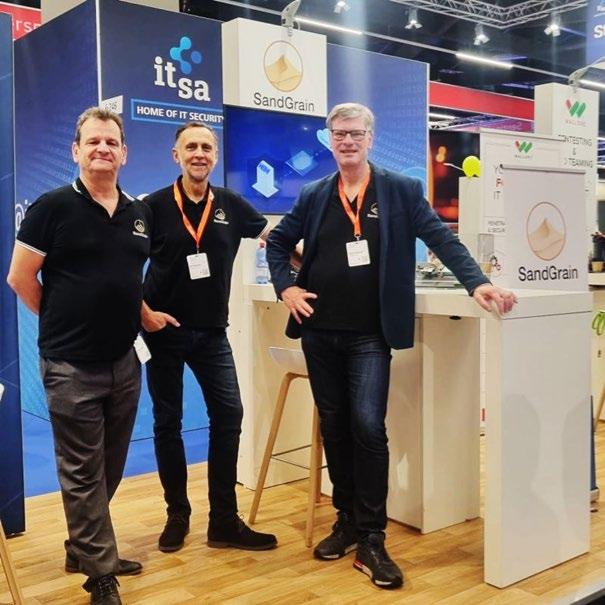

Veridis is committed to a circular economy where plastics retain their value and quality. The company has developed the innovative MADSCAN analysis technology, capable of distinguishing between different polymer fractions in large volumes and complex plastic batches with over 99% accuracy.
This technology not only delivers environmental benefits but also significantly increases the com-
Chromodynamics develops multispectral camera systems that provide real-time imaging of the chemical composition of materials. Their flagship product, the Tesseract, is a multisensor camera that captures up to twelve spectral bands in the visible and near-infrared spectrum. This technology offers deep insights into material structures and processes, optimizing applications in both industry and healthcare.
In November 2024, Chromodynamics successfully raised €2 million in funding to accelerate the
development and application of their technology. This investment highlights investor confidence in their potential to transform the fields of imaging and process optimization.
Focusing on groundbreaking innovations, Chromodynamics aims to push the boundaries of spectral imaging. Their technology opens new opportunities for research, production, and medical applications, with precision and efficiency at the forefront.
mercial value of recycled plastics. By improving accuracy, plastic manufacturers and recyclers can operate more efficiently, making compliance with new regulations more attainable.
Veridis plays a crucial role in the transition to a circular economy, addressing a global challenge: large-scale plastic recycling. With its pioneering technology, Veridis helps industries and society move toward a more sustainable future.



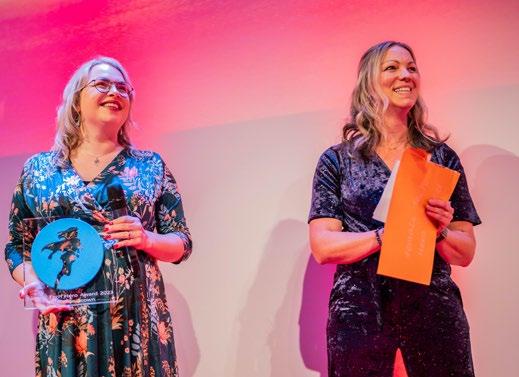



Research shows that diverse and inclusive companies are more innovative and successful. Yet achieving this balance in the tech sector remains a challenge. With Fe+male Tech Heroes, Ingelou Stol and Hilde Vocht aim not only to raise awareness but also to foster a sense of pride. “I love seeing women shine on our stage,” says Ingelou.
TEXT: EVELINE LAMERS / PHOTOGRAPHY: HTCE
What began as a small-scale event has grown into a community of 4,500 like-minded individuals. Through Fe+male Tech Heroes, Hilde and Ingelou address a clear need—one they didn’t fully realize at first. “We both work at High Tech Campus and noticed that tech companies struggle to attract female talent,” Ingelou explains. “At the same time, we heard from women working in these companies that they often feel isolated.” This inspired the duo to organize an event where women could meet and connect. “Within days, 300 people signed up. We looked at each other and knew: there’s a real need for this.”
That single event sparked the creation of an online platform filled with inspiring stories, along with additional events and dinners. These gatherings spotlight role models, often inviting them to share their stories on stage. “We aim to drive change in a positive way,” says Hilde. “That’s the vibe at our events: while our message is serious, there’s plenty of laughter too.” Last year, they even hosted their first awards show, featuring prizes such as Female Tech Hero of the Year and Male Ally of the Year. “That last one is really important to us,” adds Ingelou. “We stand for equality, which is why we included a plus sign in our name. We’re here for women, men, and everyone who identifies differently.”
It’s no coincidence that Ingelou and Hilde are committed to promoting gender equality. Ingelou says, “I’m passionate about equal rights. There’s still a pervasive mindset in the Netherlands. You see it even with kids: girls are expected to play with dolls, boys with trucks. My son is still young, but I want him to know that all toys are fine—and that it doesn’t matter whether Dad or Mom has the career, or both. Gender shouldn’t dictate those roles.”
‘Within days, 300 people signed up. We looked at each other and knew: there’s a real need for this.’
Hilde shares a similar perspective. “As a mother, I’ve often been asked how I juggle full-time work and children. I think it’s important for women to stand on their own two feet, and I try to embody that. What also motivates me is that I’m a natural connector. I love hearing that
women found each other through Fe+male Tech Heroes or seeing them shine on our stage.”
Although inclusivity and diversity have made it onto more corporate agendas in the nearly six years since Fe+male Tech Heroes began, there’s still a long way to go. Hilde notes, “Fewer than 20% of employees in tech are women. You can see it when you walk around the High Tech Campus. On top of that, the turnover rate is high. It’s a shame because diverse work environments are more innovative and successful.”
Fortunately, there are success stories too.
“At TU/e, they’ve made it their mission to hire more women across all roles, from professors to staff,” says Ingelou. “And the 25 corporate partners who’ve joined us are showing their commitment to diversity within their organizations. In return for their support, they gain access to knowledge and a network.”
Ultimately, Hilde and Ingelou hope their initiative will no longer be necessary. “We want to inspire and connect as many people as we can, until the day companies are so diverse that our work is no longer needed.”
www.femaletechheroes.com
In 2018, Hans De Neve participated in the HighTechXL “FasTrackathon” at High Tech Campus Eindhoven (HTC). He pitched his idea for a carbon capture technology developed at TNO. Surrounded by students, expat spouses, and engineers, he laid the groundwork for what would later become Carbyon. Today, the company has raised €15.3 million Series A round, of €25 million in total, to further develop its technology and plays a key role in addressing climate change.
The core of Carbyon lies in impact-driven innovation, where societal challenges take center stage. Hans explains: “Impact-driven innovation starts by addressing major societal challenges. In our case, it was climate change. From that challenge, we explored which technologies could provide a solution. It’s not about technology for technology’s sake but about a focused approach with a clear goal.”
With his background in microelectronics and materials science, Hans worked at TNO on a concept for direct air carbon capture. This concept uses ultra-thin film materials – layers just one atom thick. While promising, the challenge lay in identifying materials that were both effective at extracting CO2 and cost-effective for large-scale production. Here, the HighTechXL community offered invaluable support.
High Tech Campus Eindhoven was the perfect environment for Carbyon to get started. Through HighTechXL, Hans gained access to networks and talents from leading companies such
TEXT: CHERYL & TERRY BOYD
as ASML and Philips. For example, a Philips employee worked exclusively for Carbyon for three months, and ASML engineers were available for guidance. These collaborations enabled rapid technological progress.
Funding was also close at hand. Carbyon’s first investment came from HighTechXL, and its initial office space was at HTC 27. Hans reflects: “I had never started a company before, so I didn’t know where to begin. During the first nine months at HighTechXL, I learned everything I needed to turn an idea into a company.”
The approach proved successful. In 2022, Carbyon won $1 million in the XPRIZE Carbon Removal competition funded by the Musk Foundation. At the same time, Carbyon raised €15.3 million in one of Eindhoven’s largest Series A funding rounds.
Carbyon aims to produce 50,000 machines annually by 2031 and achieve gigaton-scale
CO2 removal by 2050. To achieve these goals, the team is expanding from its current 45 employees to 60. The visibility on High Tech Campus helps attract talent. “Many candidates apply because they’ve seen us on the Campus,” Hans says.
Despite the lure of Silicon Valley, Hans plans to stay in Eindhoven. “The combination of U.S. investment and European technology is powerful. Plus, the Campus offers unparalleled access to talent and networks.”
Hans is also giving back to the ecosystem that helped him in his early days. “I learned so much from others during the startup phase. Now I want to share those lessons.”
From an idea at TNO in HTC 25 to a scale-up in HTC 32, Carbyon’s journey spans just 450 meters on the campus, but its impact-driven mission reaches far beyond. This story demonstrates how collaboration and vision can lead to great achievements.
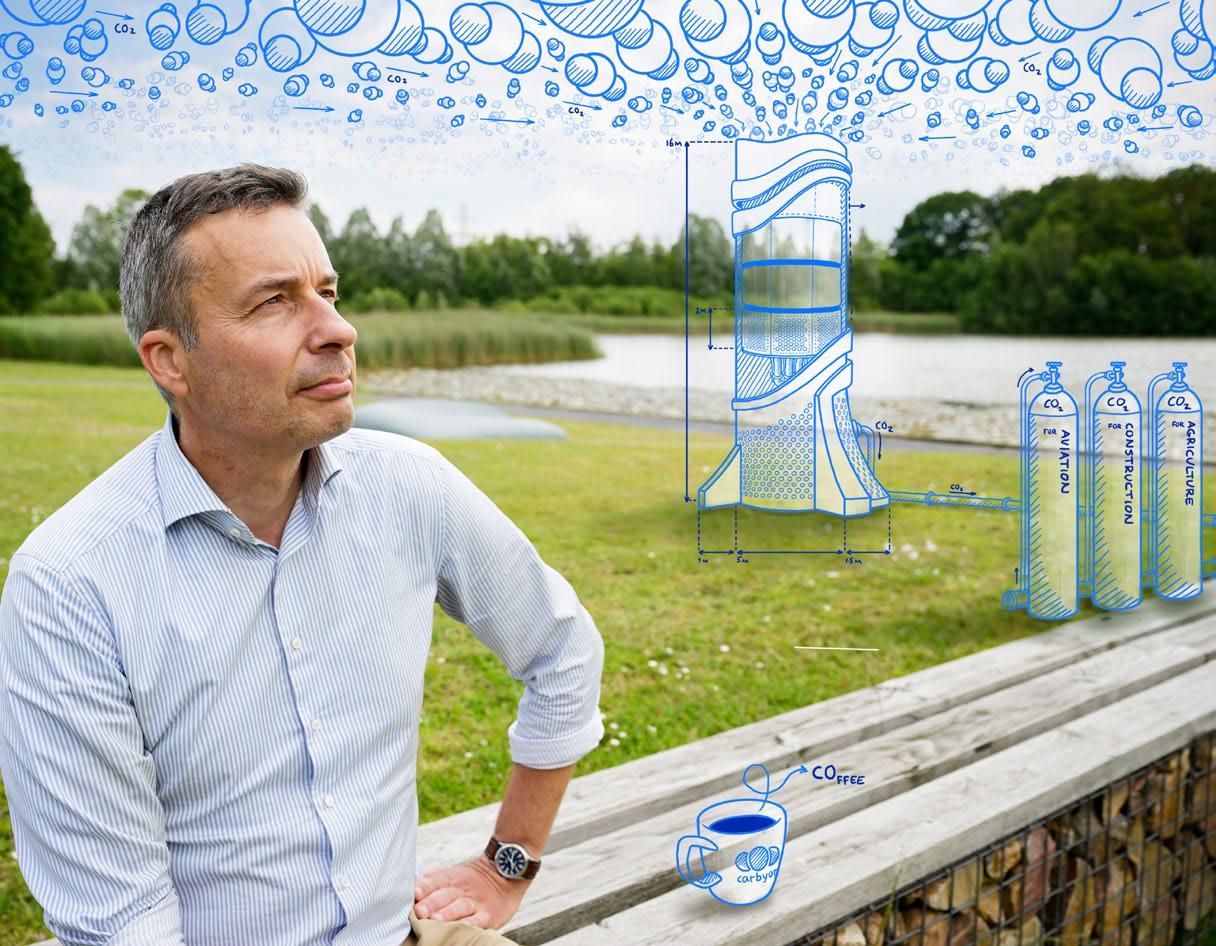
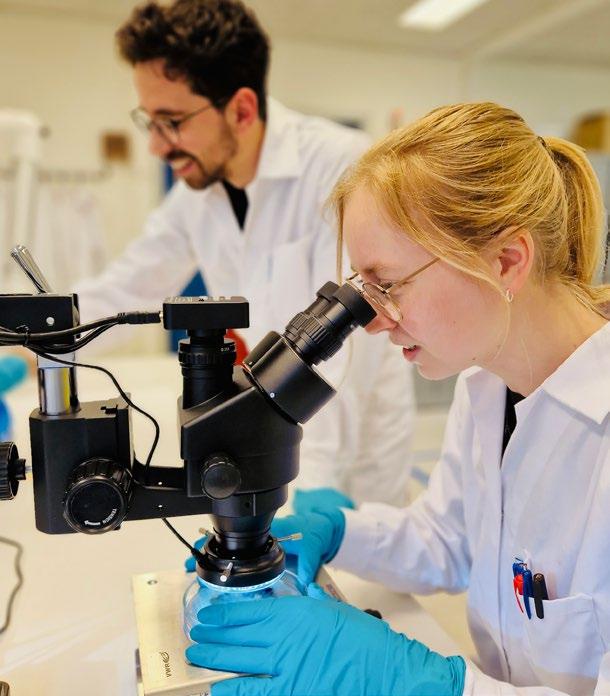



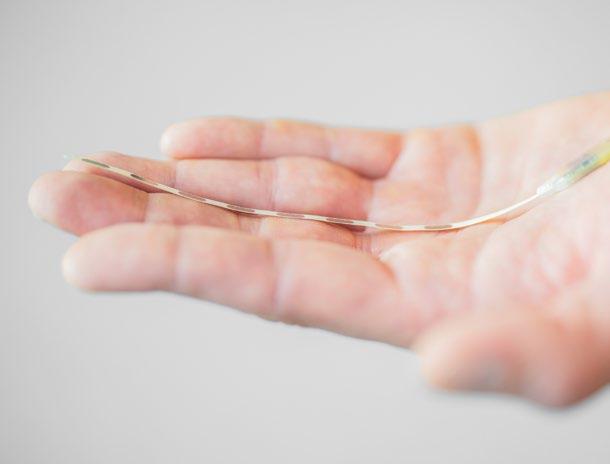

At High Tech Campus Eindhoven, companies are developing technologies that advance sectors like healthcare. One such company, Salvia BioElectronics, is working on a promising method to relieve and prevent migraines. “There are millions of people whose lives have been overtaken by chronic migraines. We want to give them their lives back.”
A paper-thin implant, placed just under the skin at the forehead and back of the head, is the innovative solution from Salvia BioElectronics aimed at alleviating and preventing migraines. “What we do is communicate with the nervous system. Just as a pacemaker restores heart rhythm, this therapy is designed to calm the nerves involved in migraines,” explains Hubert Martens, CEO and one of the three co-founders. “Patients with this paper-thin implant also receive an external headset. With the push of a button, they can start their therapy themselves—an hour in the morning and evening for prevention or as needed when they feel a migraine attack coming on.”
The company, based at High Tech Campus, aims to make a significant difference for a large group of people. Hubert explains, “Chronic migraines affect one to two percent of the global population. Patients are primarily young women, around thirty years old. Many don’t find sufficient relief with current therapies or medication, leaving them unable to work and missing out on large parts of their social lives. Some are even hesitant to start a family because of their condition. With
TEXT: EVELINE LAMERS
‘We want to give them hope for a brighter future’
our therapy, we want to give them hope for a brighter future.”
The migraine therapy was first conceived in 2017 on a whiteboard by Hubert and co-founders Daniel Schobben and Wim Pollet. Seven years later, the startup has evolved into a medical company conducting studies in Europe and Australia to demonstrate the safety and effectiveness of the implant. Early test results are very promising. “We sometimes receive letters from patients expressing what the therapy has meant for them. That’s incredibly special. But more and larger studies are needed to prove its effectiveness.” The ultimate goal: within a few years, migraine patients worldwide should have the option to choose this therapy from their neurologists.
Today, a team of 50 people—43 percent of whom are women, representing 15 nationalities—is working toward this shared mission. The choice to operate from High Tech Campus is deliberate. Hubert says, “It’s a fantastic environment—green, with great facilities, and perfect for our team. Plus, the proximity of technical expertise and infrastructure from other high-tech companies gives us the opportunity to collaborate and share knowledge.”
Hubert is proud of how far Salvia has come but acknowledges the challenges they’ve faced over the years. “As a medical company, you have a significant impact on people’s lives. Our product has to be safe and reliable, which means extensive research and testing. Bringing a safe product to market is a long journey that requires tremendous perseverance.”
His advice for other entrepreneurs? “Keep going. It’s a marathon, not a sprint. You can’t prepare for every obstacle or waste energy worrying about them. What matters is how you respond and that you push through.”
The combination of High Tech Campus Eindhoven (HTCE) and PSV’s women’s division may not seem obvious at first glance. Yet the Campus name is boldly displayed on the shirts of the Eindhoven female football players. It reflects a shift in sports sponsorship. HTCE and PSV Women reinforce each other. “In essence, we share the same ambition,” says Sandra Doreleijers, Manager of Women’s Football at PSV. “We believe in women’s potential.”
TEXT: KOEN CHATROU / PHOTOGRAPHY: PSV MEDIA
In 2017, Sandra joined PSV during a period when the women’s division made the switch from a commuter train to a high-speed rail. We sit at De Herdgang, overlooking the spot where the women’s team will have their own facilities next year. Reflecting on those early days, she says, “When I first came here, we still trained late in the day, always on artificial grass. Locker rooms were assigned last minute based on availability. There were no dedicated uniforms for the women, and meals for the players were scarce. The club was clearly still finding its footing.”
Today, anyone walking around the matches or training sessions of the women’s division at the PSV training complex will sense the professional atmosphere that now surrounds the team. Sandra explains: “PSV has embraced women’s football. What applies to the men now applies to the women as well. It has to be top-notch, and we are expected to perform. The women’s division has become worthy of the PSV name. You feel it throughout the entire club. Our facilities are at least on par with those of top European women’s football teams. The foundation is there, and we’re building on it.”
Currently, in addition to the first team, PSV Women also includes Jong PSV, which has already
won the national championship twice, as well as U-16, U-15, and U-13 training groups.
‘PSV has embraced women’s football. What applies to the men now applies to the women as well.’
With this foundation, PSV Women now stands firmly among the national elite. The players are full-time professionals, and the ambitions are clear. “We aim to compete for the league title, win the national cup, and play in the Champions League,” Sandra says confidently. “I have great faith in our team. Our staff is now at a level where we can continue to grow technically, tactically, and physically.”
The growth of women’s football has also had an impact on attracting sponsors—or is that term becoming outdated? “I’m extremely proud of
our sponsors. And yes, the days of beer and bitterballen in a business lounge are over. Take our partnership with HTCE, for example. We don’t see it as just sponsorship but as a true partnership. HTCE believes in the potential of women. Together, we see the challenge of sharing that story. Moreover, innovation—the hallmark of HTCE—is becoming increasingly important in our sport.”
In that spirit, PSV Women, together with BrabantSport and HTCE, organized an Innovation Challenge last year, inviting companies to pitch innovative ideas in the field of sports. TNO won the challenge with the concept for a 3D-printed energy bar designed to promote post-match recovery and alleviate menstrual symptoms. The further development of this bar is now taking place at De Herdgang.
Sandra is proud of the collaboration with HTCE, especially the way it has evolved. “Developing and shaping ideas together in a way that benefits both parties. This combination may not seem logical at first glance, but there are so many connections. It just fits. The common thread? That we create opportunities for women and showcase the high level at which we can perform—both in business and in sport.”
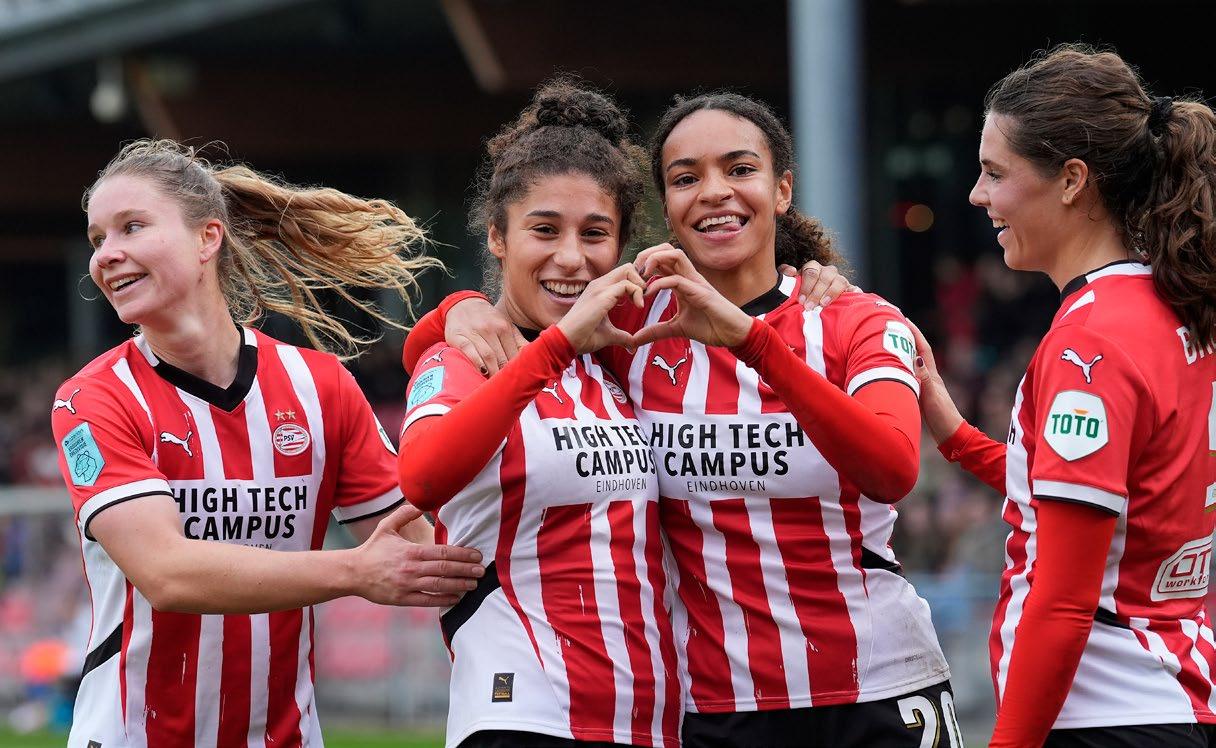







TEXT: BREGJE VAN DOMMELEN
PHOTOGRAPHY: CHARLOTTE VERHAGEN - DCI MEDIA
The chips developed by SMART Photonics don’t use electrical signals but light, offering enormous advantages. “Moving light doesn’t consume energy. Fiber optics don’t generate heat, unlike copper wires. This saves a tremendous amount of power. Additionally, our chips can transmit much more information simultaneously. An electron can only be on or off—1 or 0. Light, on the other hand, can be on or off, but also come in different colors and phases. This gives us far more possibilities. We’re truly on the brink of monumental technological breakthroughs. I often compare this to the 1970s when no one could imagine we’d all carry mobile phones in our pockets one day.”
SMART Photonics was among the first companies to develop complex optical chips back in 2012. Today, the company is riding the wave of growing interest. Policymakers in the Netherlands and Europe increasingly recognize the importance of having a homegrown chip industry.
“We outsourced semiconductor production to Asia years ago, and the rest is history... Europe doesn’t want to make that mistake again. There are now funds available, and more major companies are showing interest in what we offer.”
SMART Photonics and design houses assist companies in creating the perfect chip tailored to their needs. “Think of it as a box of LEGO.
Imagine this: Instead of hospital visits for an MRI, you use a portable, affordable device to monitor your health at home. Or using ChatGPT in a more sustainable, energy-efficient way. A futuristic vision? Perhaps, but not for long if SMART Photonics CEO Johan Feenstra has his way. “The optical chips we produce here at High Tech Campus Eindhoven will make these and countless other advancements possible,” he says.
From individual pieces, you can create various designs, all fitting on a single square millimeter chip. There’s a laser, a waveguide, an amplifier, and much more. The combination and arrangement of these components can be customized to meet specific requirements.”
Developments are progressing rapidly, with SMART Photonics hitting one milestone after another. “But the most significant achievement this year is transitioning from 3-inch to 4-inch wafers. This makes applications much cheaper and therefore more attractive. A 3-inch wafer can hold 200 to 300 complex chips, depending on the application. A 4-inch wafer doubles that. It sounds simple, but it took us a year and a half to achieve.”
SMART Photonics’ philosophy is to bring others’ innovations to life.
“We help other companies make significant strides with our chips.”
That doesn’t mean Feenstra underestimates his company’s importance. “We aim to be the global leader in our field, and we’re well on our way. We want to be the first company that comes to mind when someone needs optical chips.”
Achieving that position is no easy feat. “SMART Photonics started as a lab with a group of incredibly smart researchers. The challenge now is to maintain an innovative culture while also becoming a reliable, commercially operating factory. Our next step is to reach tier one, the top level.”
Being located in Brainport is undoubtedly a factor in SMART Photonics’ success. “The term ‘ecosystem’ is often overused, but here, it truly applies. We collaborate fruitfully with research institutes and other companies. There’s an incredible amount of expertise here.”
Not every startup successfully scales, but SMART Photonics has managed to do so. Feenstra’s secret? “It’s never too early to bring in great people. Don’t hesitate. Only with fantastic people can you build a fantastic company.”
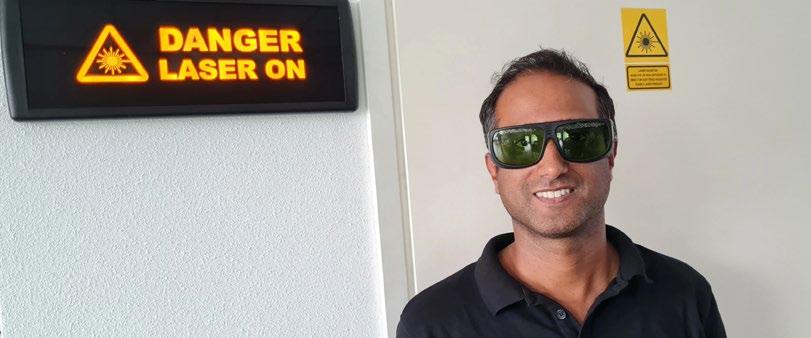



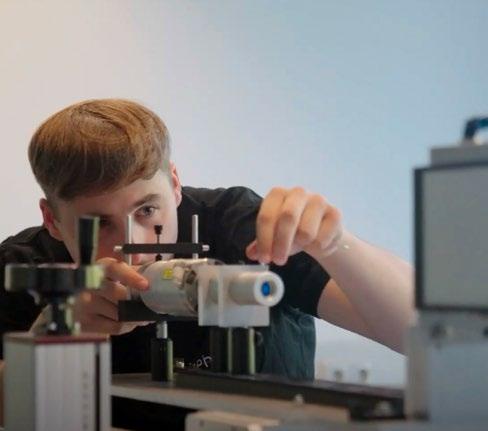
TEXT: CHERYL & TERRY BOYD
inPhocal’s technology offers a sustainable alternative to traditional marking solutions. Worldwide, five billion bottles and cans are produced daily, typically marked with ink. This leads to 160 million liters of ink waste annually. inPhocal aims to eliminate this with their laser technology.
“Our laser technology is three times faster, and up to ten times more efficient on curved surfaces, compared to current systems,” explains van Tankeren. This speed makes it possible to laser unique QR codes, something existing technologies cannot achieve. Bottling facilities benefit from faster, low-maintenance systems while significantly reducing environmental impact.
According to CTO Martijn Boerkamp, inPhocal’s system is already three times faster than competing solutions, with plans to make it four times faster soon. While the current focus is on the beverage industry, inPhocal also has longterm ambitions in the semiconductor market.
inPhocal’s journey started five years ago on the High Tech Campus Eindhoven. Originating from CERN technology, the startup joined the HighTechXL program in 2019, where the team developed expertise, created a business plan, and secured initial funding.
Since then, inPhocal has refined its technology, secured patents, and installed systems on pro -
inPhocal has much to celebrate. Recently, the team marked its fifth anniversary and opened a new office in HTC 32, complete with their own laser system. As a deep-tech scale-up, inPhocal develops advanced high-precision laser technology. Its unique long-focus laser beam increases speed and quality, even on curved surfaces.
“We’ve invented a new optical technology that makes laser processes much more efficient,” says CEO and co-founder Robert van Tankeren.
duction lines. With a team of 20 employees, the company remains committed to the Campus, which they see as crucial for their growth.
“The level of innovation and collaboration here – with companies like ASML, Philips, and startups – is unique,” says van Tankeren. “We even repurpose surplus equipment from other companies, which is a great advantage.”
The pandemic initially forced the team into a virtual workspace, but returning to the physical environment of the Campus made a significant difference. “Now we can share knowledge, use inhouse labs, and be part of an innovative community,” he adds.
After rapid growth, inPhocal outgrew its space at HTC 27 and moved to HTC 32. The team plans to expand to 50 employees in the coming years. “We’ve already discussed adding an extra wing in our current building with the Campus,” says van Tankeren. “It’s the ideal setup for us to grow from a single, central location.”
With a production facility outside the Netherlands, inPhocal envisions a scalable model to replicate production facilities globally while keeping its headquarters in Eindhoven. The Campus also supports their efforts to attract international talent. “The innovative ecosystem here helps convince people to relocate and contribute to our work,” van Tankeren explains.
Laser marking is just the beginning for inPhocal. Their technology has potential applications in industries such as semiconductors, automotive, and healthcare. “Laser processes are widely used in these fields, and our technology makes them more efficient,” van Tankeren notes. “This means less energy use, fewer production steps, and reduced waste – making the world a bit better.”
inPhocal aims to become a tech leader with vast market potential. With the support of the High Tech Campus, they’re well-positioned to grow – not only now but as they work toward their bigger dreams.






The 5 basic principles of employeneurship

A long-term working relationship



Individual profit sharing






Business cells
YOUniversity
The Entrepreneurial Lab





























Partnerships for vital work environments







In 2021, Fontys, imec, TNO, Eindhoven University of Technology, and High Tech Campus Eindhoven launched the Workplace Vitality Hub. This innovative ‘smart office’ connects science and practice to create healthier and more vital work environments.
Smart Office and Living Lab
The Workplace Vitality Hub functions as a Living Lab. Together with our partners, we research, develop, and test (new) technologies and solutions to enhance vitality in the workplace.














Visit Our Experience Centre
At our Experience Centre, you can experience first-hand how innovation can improve the workplace and work experience. Visit us at High Tech Campus 85 in Eindhoven and get inspired.
Become a Partner of the Workplace Vitality Hub
Visit our website to explore whether a partnership could benefit your organisation!
www.workplacevitalityhub.nl
Transform dark spaces into inviting spaces.

How does it feel to have sunlight above your head, even when you're in a space without natural daylight?
Do you have a space with limited or no access to daylight?
NatureConnect is the solution!


NatureConnect replicates daylight, simulates the sun‘s daily patterns, and recreates a view of the sky.
The NatureConnect system consists of luminaires and a scene-setting feature for automatic day rhythm simulation, as well as various scenes to select the right light for the right moment. This can easily be managed using a user-friendly wall switch.



Benefits of NatureConnect:
Enhance well-being: Supports the body‘s natural day-night rhythm to stay active during the day and rest well at night.
Improve performance: Helps people feel more energized and fosters interaction and collaboration.
Create an inspiring environment: Strengthens your company’s identity by creating a vibrant, uplifting, and immersive atmosphere.
Curious to learn more? Click the link below or scan the QR code! https://www.signify.com/global/innovation/natureconnect

the platform for everyone who wants to be part of Dutch innovation.
At IO+, the future of Dutch innovation takes shape, and changemakers come together. Our stories and events show what the world of tomorrow looks like.
